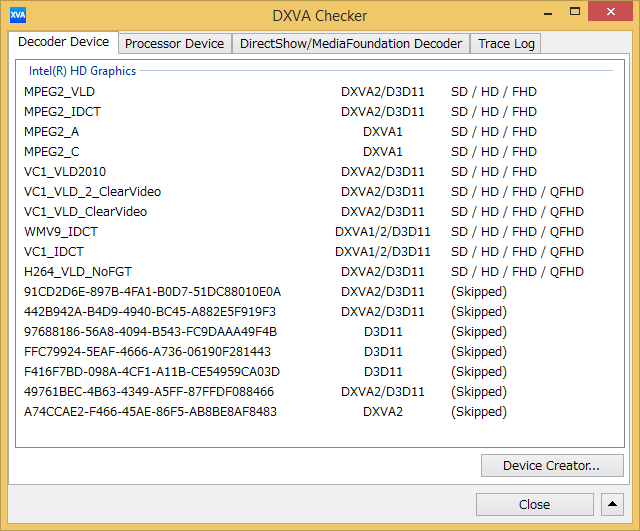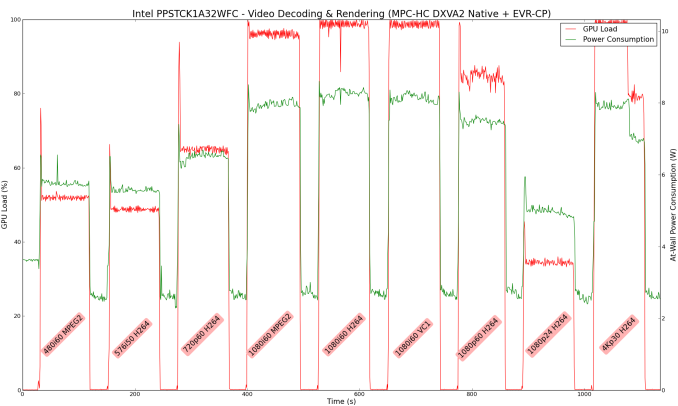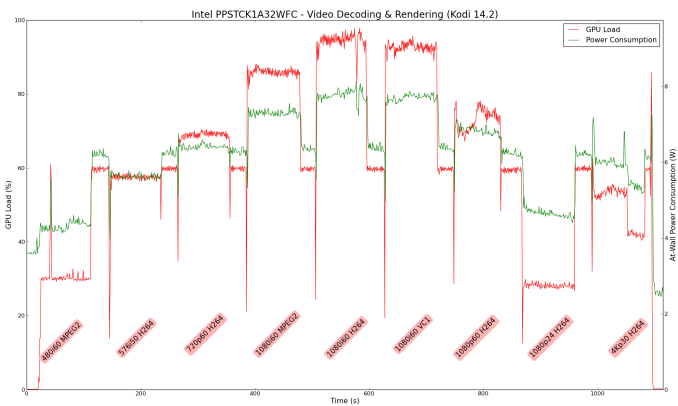Intel PPSTCK1A32WFC Bay Trail-T Compute Stick Review
by Ganesh T S on April 22, 2015 11:00 AM EST- Posted in
- Systems
- Intel
- Bay Trail
- HDMI Stick
HTPC Credentials
Usage of the Compute Stick as an entertainment platform is promoted by Intel as one of the use-cases. It is a bit surprising (given the form factor) that the Compute Stick has a fan. Subjectively, I was not comfortable with the acoustics in a 'office scenario' with the Compute Stick at the base of the monitor (connected via the HDMI extender cable) and myself seated around 70 cms. from it. The small diameter of the fan makes for a whining high-pitched noise, and it is compounded by the fact that it starts and stops depending on the SoC load.
Objectively speaking, Intel provided an acoustics rating of 28 dB at 1m distance for the noisiest mode. If the Compute Stick were to be hidden behind the TV, it is unlikely that users can hear such low noise at typical television viewing distances. It is not ideal, but Intel indicated that the performance of the device needs proper thermals. In order to to balance the very small size along with overall cost and performance, they went with a small fan as the optimal thermal solution. Now that we have got the acoustics out of the way, let us move on to the other HTPC aspects.
Refresh Rate Accurancy
Starting with Haswell, Intel, AMD and NVIDIA have been on par with respect to display refresh rate accuracy. The most important refresh rate for videophiles is obviously 23.976 Hz (the 23 Hz setting). The Intel PPSTCK1A32WFC has no trouble with refreshing the display appropriately in this setting, but it is not as accurate as Haswell or Broadwell or even other Bay Trail-based systems (refreshing at 23.973 Hz instead of 23.976 Hz).
The gallery below presents some of the other refresh rates that we tested out. The first statistic in madVR's OSD indicates the display refresh rate.
Network Streaming Efficiency
Evaluation of OTT playback efficiency was done by playing back our standard YouTube test stream and five minutes from our standard Netflix test title. Using HTML5, the YouTube stream plays back a 720p encoding. Since YouTube now defaults to HTML5 for video playback, we have stopped evaluating Adobe Flash acceleration. Note that only NVIDIA exposes GPU and VPU loads separately. Both Intel and AMD bundle the decoder load along with the GPU load. The following two graphs show the power consumption at the wall for playback of the HTML5 stream in Mozilla Firefox (v 37.0.1).

GPU load was around 51.56% for the YouTube HTML5 stream and 4.53% for the steady state 6 Mbps Netflix streaming case. Mozilla Firefox is terribly inefficient in terms of power for YouTube playback. The same test stream, when played back in Internet Explorer, consumed only 3.55 W on an average and had a GPU load of 9.1% for the same H.264 stream.
Netflix streaming evaluation was done using the Windows 8.1 Netflix app. Manual stream selection is available (Ctrl-Alt-Shift-S) and debug information / statistics can also be viewed (Ctrl-Alt-Shift-D). Statistics collected for the YouTube streaming experiment were also collected here. The power efficiency of the Compute Stick platform comes to the fore here.

Decoding and Rendering Benchmarks
The form factor of the Compute Stick and the internal components make it clear that consumers are not going to play back videos using the madVR renderer. Instead, it is highly likely that Kodi will be used as the interface for media playback. We evaluated performance under MPC-HC + EVR-CP and Kodi 14.2 for our test suite. Prior to those results, let us take a look at the codecs that are hardware-accelerated by the Bay Trail-T SoC.
As expected, we have acceleration for MPEG-2, VC1, WMV9 and H.264. HEVC is not necessary for such a platform at this point in time.
In our earlier reviews, we focused on presenting the GPU loading and power consumption at the wall in a table (with problematic streams in bold). Starting with the Broadwell NUC review, we decided to represent the GPU load and power consumption in a graph with dual Y-axes. Nine different test streams of 90 seconds each were played back with a gap of 30 seconds between each of them. The characteristics of each stream are annotated at the bottom of the graph. Note that the GPU usage is graphed in red and needs to be considered against the left axis, while the at-wall power consumption is graphed in green and needs to be considered against the right axis.
Frame drops are evident whenever the GPU load consistently stays above the 85 - 90% mark. In addition to tracking that aspect in the graphs below, we also get an idea of the system's power efficiency for decode and playback of some common codecs.
The above graph suggests that the Compute Stick is likely to drop frames when deinterlacing of high frame rate content is required. It is possible that EVR, the native renderer, will perform better than EVR-CP.
Kodi doesn't deinterlace content by default - so, the GPU load goes unreasonably high only for the 1080i60 stream. Another aspect to observe with Kodi is that 'idling' at the XBMC interface consumes around 60% of the GPU resources and the power penalty is around 6 W. Depending on the codec and frame rate, the GPU load and power consumption might be lower or higher than the 'idle' state. For example, 480i60 and 1080p24 videos play back within the 5 W power envelop.
Note on HD Audio Bitstreaming
As of April 2015, the Intel graphics drivers for Bay Trail-T (32-bit) have support only for bitstreaming of DTS, Dolby Digital and Dolby Digital Plus. This means that Netflix and other similar OTT sites are in the clear. However, users hoping to take advantage of lossless HD audio in Blu-ray backups are going to be disappointed. In any case, streaming of Blu-rays over a 802.11n Wi-Fi network will result in a bad user experience. So, it is possible that the absence of HD audio bitstreaming will not bother too many consumers.



















103 Comments
View All Comments
ToTTenTranz - Wednesday, April 22, 2015 - link
IMO, lack of Ethernet and terrible WiFi performance kills the product from the start.This is obviously intended to turn a TV into a media host device with the added functionality of running Windows, but if a very slow WiFi connection is the only way to get connected, then the product is rather useless.
With a decent WiFi AC receiver, this would be the ideal Steam Home Streaming client.
Krysto - Wednesday, April 22, 2015 - link
Slow and expensive for what it offers - I'd say that defines Intel pretty well these days.Krysto - Wednesday, April 22, 2015 - link
Oh and don't forget this is the kind of "Celerons" and "Pentiums" we're going to see from now on - for $100-$160 a chip.Drumsticks - Wednesday, April 22, 2015 - link
Not really sure why you're ignoring the $50 Celeron G1820 which is a 2.7Ghz Haswell chip, but hell if it makes you feel better go ahead.Drumsticks - Wednesday, April 22, 2015 - link
Edit: And if you're referring to mobile bay/cherry trail parts, it's not like consumers can personally buy those anyways.Refuge - Wednesday, April 22, 2015 - link
Thats right, because Microsoft lets Intel use Windows for FREE.Forgot that deal.
v1001 - Wednesday, April 22, 2015 - link
Wait a minute so every single one of these is going to crap out when people go to add the windows updates?? How is that acceptable? They can't seriously expect everyone who buys this to find a work around do they? Is Windows 10 smaller? Any luck there with upgrading to that in July? I want to buy a few of these for some TV's. But I'm not going to cut it that close on the updates, I mean what happens on the next windows update and that's it, you went over and can't do a single thing after that...Marc GP - Wednesday, April 22, 2015 - link
Looks like you'd be much better served with something like the HP Stream Mini.Uplink10 - Thursday, April 23, 2015 - link
Stop advertising HP Stream Mini, Zotac miniPC or Gygabite BRIX barebones are better and you can even put in youtr desired HDD and RAM and they only cost around 120$. See my post above.dtgoodwin - Wednesday, April 22, 2015 - link
I'm surprised that they had issues with updates. I'm running a Winbook 7" with only 1GB of ram and 16 GB on board storage. I've added a microSD 64-gig card, but windows updates will only stage/install on the c: partition. I've got less than 1 GB free, but all the updates have applied - I just got this two weeks ago, so I'd consider it a fairly comparable situation. I did run disk cleanup including system updates, but I never ran into an error. It is too bad that there's no way to extend the drive space of c: using a microSD, or to have Windows seamlessly use it for temp files, or be able to move other files to it. It would also greatly help if they allowed you to move the "recovery" partition to a USB stick and be able to recover by placing that back in the device. Recovering 5 GB of space would be really helpful. Of course, my tablet only cost $40.00. It also plays NetFlix and Youtube output to HDMI acceptably, and even my medium bitrate Blu-Ray rips.